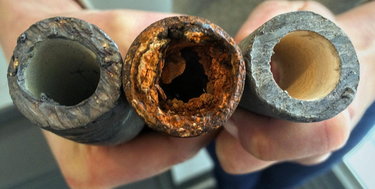Altamont water did not have to be tested for asbestos following pipe break, county says
ALTAMONT — Following the late September pipe burst on Schoharie Plank Road West, village water was tested but not for a well-known cancer-causing material.
Altamont Superintendent of Public Works Jeff Moller told The Enterprise in mid-November testing was not needed when the asbestos-cement pipe broke since decades of microorganism had built up, called “biofilm,” which acts as a barrier between the village water supply and asbestos pipe. Moller said that all water lines protect themselves in the same way.
Asked this week to explain the safety of biofilm, Moller clarified that his department injects orthophosphate into the water at the source, its wells. He said orthophosphate is a corrosion inhibitor. It forms a layer of calcium carbonate inside the pipes, which acts like a pipe inside the pipe.
Moller said the village has been injecting the water with orthophosphate for a decade, ever since the Brandle Road wells came online. The village injects at both of its water sources: Gun Club and Brandle roads, he said.
Mary Rozak, spokeswoman for County Executive Daniel McCoy, in a statement to The Enterprise last week about the break said: “This water main break occurred over two months ago, and a portion of the water main was repaired. They are not mandated to notify us of a water main break unless it is for more than 4 hours and or a significant loss of pressure occurs. Neither of these conditions were met in this case.”
Moller explained the conditions hadn’t been met because Altamont has to notify the county when the entire village water system is down for either four hours or a significant loss of pressure in the entire system occurs for four hours, neither of which occurred.
Moller said the system pressure dropped for an hour “at the most.”
However, the pressure drop was unusual.
At the Nov. 2 board of trustees meeting, Moller said of the Schoharie Plank Road West, “I think it shocked our whole system because it dropped pressure in the whole system, which hardly ever happens.”
Moller attributed the increase in main breaks to the late September blowout on Schoharie Plank Road West. “I’ve been here for 20 years and we’ve never had a break where it just drops the pressure right out, [and] people don’t have water, three-quarters of the village,” Moller said on Nov. 2. “It’s pretty severe.”
The older mains are more susceptible to biofilm buildup, Moller told The Enterprise in mid-November, “which is good. But in another sense, it cannot be good.” If too much of the biofilm gets built-up, bacteria starts to grow on the buildup and “your chlorine can’t reach it,” he said.
That’s one of the reasons why villagers will see hydrants being flushed. Moller’s department flushes out the water mains twice a year so the biofilm doesn’t get too built-up.
Moller and his DPW crew have to be careful if they cut into an asbestos-cement pipe — but the department doesn’t use “any cutting machines like we normally would on a water main to create dust,” he said, so, other than protecting the workers, the village doesn’t have to do anything extra in terms of safeguarding, because of the biofilm, he said.
Professor Yanna Liang, who chairs the Department of Environmental and Sustainable Engineering as well as the College of Engineering and Applied Sciences at the University at Albany, was asked by The Enterprise, generally speaking, could biofilm protect the water supply from an old pipe, any type of pipe — regardless of a break — to which Liang replied, “The biofilm can do good or can do bad.”
Liang said biofilm is a very general term and she did not know what is in Altamont’s pipes. “Without any testing, I don’t know what you have,” Liang said.
If residents think they may have an issue with water quality, Liang advised they contact the state’s Department of Environmental Conservation. The DEC directed The Enterprise to the county health department for answers to its concerns.
Moller said the village has to sample the water. “I don’t know how many samples we sent out because of that,” he said of the late September break of the asbestos-cement on Schoharie Plank Road West. He said his department tested for bacteria both upstream and downstream of the break, but did not test for asbestos.
Asked how much asbestos-cement water pipe Altamont has, Moller said, “There isn’t that much really at all.” But his response came with a caveat: “This is what we know of,” meaning knowledge was attained through years of digging up water-main breaks.
Moller said there is asbestos-cement pipe on Maple Avenue Extension and Schoharie Plank Road West. “And right now, those are the only places that we really know that we have it in our system,” he said. And not all of Schoharie Plank Road West is asbestos-cement pipe, Moller said; a lot of the main is cast iron.
Asked about testing for asbestos, Moller said, “It’s all done through our testing,” but it may not be annually — it depends on a testing schedule, which could take place every year, every two years, or even every three years. “It all depends,” he said.
The annual drinking-water quality reports available on the village website, from 2018 and 2019, have no mention of asbestos testing.
County testing archived on the Environmental Protection Agency website dating back to 2003 found no deficiencies with the village water. But the EPA also notes Altamont was cited for violations three times by the state in that same period, typically for having higher-than-allowable levels of disinfectants in the water.
A known carcinogen
“The primary reason for concern about drinking water containing asbestos fibers is the association between occupational asbestos exposure and gastrointestinal cancer shown in a number of occupational epidemiology studies,” according to the EPA. “Although the asbestos worker is exposed to airborne asbestos it has been clearly demonstrated that a high percentage of inhaled fibers deposited in the lung are cleared and swallowed. So, they are also exposed to ingested fibers. There have been a number of recent studies which have shown that asbestos fibers can penetrate the digestive tract and even are excreted through the urine.”
Dr. Arthur Frank, a medical doctor with a Ph.D. in biomedical sciences and an expert in asbestos-related diseases at Drexel University in Philadelphia, told The Enterprise that people think of asbestos only as being dangerous to inhale.
Malignant mesothelioma is an aggressive and deadly form of cancer, which occurs in the mesothelium, a layer of tissue that covers most internal organs. It most often affects the tissue surrounding the lungs but can also affect tissue in the abdomen; around the heart; and, in males, around the testes.
Asbestos exposure is the primary risk factor for mesothelioma.
In the chest, the asbestos is believed to enter through inhalation, Frank said.
In the abdomen, he said, asbestos can enter through the diaphragm — it’s breathed in — but more often it’s ingested. “We swallow it,” Frank said. “And when you swallow it, it goes down into your intestines.”
There are two issues when discussing asbestos exposure: First, how much does it take. And second, when someone has been exposed, when did he or she get the disease, also called latency.
“Most things in humans that cause cancer, not everything, but most things, we have something we call the 20-year rule,” Frank said. “It takes at least about two decades before you start seeing cancers.” For example, people who start smoking in their teens usually get lung cancer in their 50s and 60s. “If they start smoking at 16, they don’t get cancer at 20.”
“So the latency for asbestos cancers is 20 years or more,” Frank said.
Frank says there’s growing research that shows ingested asbestos has been linked to esophageal cancer, stomach cancer, and small and large bowel cancer, as well as kidney cancer.
Asbestos fibers have even been shown to cross through the placenta of a pregnant woman into a developing newborn, he said.
As for time, Frank said, just one day of exposure has been shown to give both humans and animals mesotheliomas — which is because the asbestos fiber can get into your system and just stay there. “Now, the one-day-of-exposure cases, I can count them on one hand, literally,” Frank said.
Frank said asbestos-cement water pipes pose a risk for the people who made the product, for those who installed the pipes, and for the workers who repaired them, “but the other thing is, when the pipe is in the ground carrying water, it leeches the fibers out of it.”
Frank said the reason there was a blowout in Altamont is that asbestos-cement pipes thin-out over time, they get worn away, and the asbestos in the pipes comes out as well.
Asked about Moller’s mid-November explanation for not needing to test the water since it was protected from the asbestos pipe by the biofilm, Frank acknowledged the buildup but again said, “We also know that asbestos does leach out of pipes.”
About orthophoshate’s effectiveness to protect the water supply, Frank said he couldn’t speak to it. But he added that the village should be testing the water to see if it meets the EPA standard of seven million fibers per liter of water.



